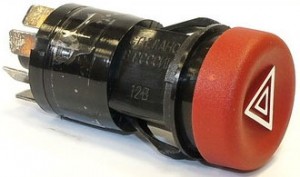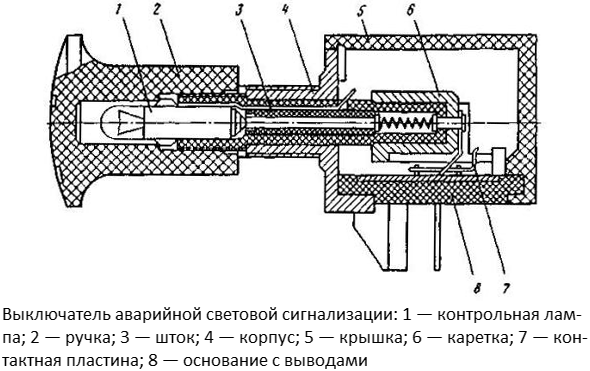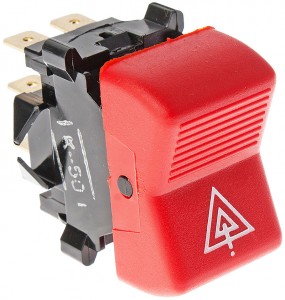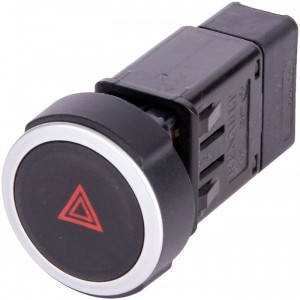
In accordance with current standards, each car must have a light hazard warning controlled by a special switch. Learn all about alarm switches, their types, design and operation, as well as the correct choice and replacement of these devices - find out from the article.
Purpose and role of the hazard alarm switch in the vehicle
Alarm switch (emergency switch) - the control body of the light signaling system for cars and other vehicles; A switch of a special design (switching device) that provides manual switching on and off of the light alarm, as well as visual control of the functioning of this system.
In accordance with the current Russian and international standards, each wheeled vehicle must be equipped with a light hazard warning ("hazard light"). This system is used to notify other road users about various potentially dangerous or emergency situations - accidents, stops in a prohibited place, the need to provide medical assistance to the driver or passenger, while towing another car, in case of blinding the driver in the dark (headlights of oncoming traffic), as well as when boarding / disembarking children from buses and other special vehicles, etc.
"Emergency" is built on the basis of direction indicators (main and repeaters, if any), which, when the system is turned on, are immediately transferred to intermittent operation. Switching of direction indicators to transfer them to intermittent mode (blinking) is carried out by a special switch located on the dashboard. The switch is an important part of the system, its malfunction leads to incorrect operation of the "emergency light" or its complete failure - this reduces the safety of the vehicle and makes it impossible to pass the inspection. Therefore, a faulty switch should be replaced with a new one as soon as possible, and in order to make the correct repair, it is necessary to understand the existing types of these devices, their design, operation and features.

Alarm switch design
Types, device and principle of operation of the alarm switch
Today's switches have a fundamentally identical design, differing only in appearance and some details. The device is based on a contact group of movable and fixed contacts, some of which are normally closed (in the off position, they close the circuit), and some are normally open (in the off position, they open the circuit). The number of contacts can reach 6-8 or more, with their help a large number of circuits are switched at once - all direction indicators with the corresponding relays, as well as a signal lamp / LED built into the switch.
The contact group is placed in a plastic (less often in a metal) case, on the front surface of which there is a button / control key, and on the back there are terminals for connecting to the electrical system of the vehicle. The most commonly used are standard knife terminals that are compatible with the corresponding terminal blocks or individual terminals. In domestic cars, switches with a standardized arrangement of terminals in a circle are widely used, and appropriate terminal blocks are produced for such devices.
Mounting elements are located on the switch body, through which the device is fixed in the place intended for it - in the dashboard or in the steering column. In cars of the early years of production, as well as in many modern domestic trucks, the installation of switches is carried out with screws or nuts (one nut is screwed onto the thread provided on the body). In new vehicles, switches are often installed without the use of any threaded fasteners - for this, plastic latches, springs and stops are made on the body of the device.
According to the method of control, there are two types of alarm switches:
● With lockable button;
● With key switch.
Devices of the first type are equipped with a button with a locking mechanism, the alarm is turned on and off by pressing the button - it is transferred to one position or another, holding in it and providing switching of the direction indicator circuits. Thanks to the locking mechanism, there is no need to hold the button with your finger. Usually, the button is round and large, although in modern cars you can find buttons of various shapes (square, oval, triangles, complex shapes) that fit into the overall design of the interior and dashboard.

Push-button switch

Key switch
Devices of the second type are equipped with a key switch with two fixed positions, the activation and disabling of the "emergency light" is carried out by pressing the corresponding side of the key. Like buttons, keys can have a more or less standardized design, or be made for use in a specific range of cars.
All emergency switches are standardly indicated by a pictogram in the form of a triangle, which can have one of three versions:
● In modern vehicles, there is a triangle outlined by a double white stripe, located on a red background;
● In old vehicles - a triangle outlined by a wide white stripe, located on a red background;
● Less often in modern vehicles - a triangle outlined by a double red stripe, located on a black background (fits into the overall dark design of the dashboard).
Under the button/switch key (or directly in it) there is an indicator lamp / LED, which operates in intermittent mode synchronously with the direction indicators - this is how the alarm is monitored. The lamp/LED is located either directly under the transparent button or under the transparent window in the button/key.
Switches are available for a supply voltage of 12 and 24 volts and usually have an operating current of no more than 5 amperes. Their connection to the vehicle's mains is carried out in such a way that when the alarm is turned on, all direction indicators and the warning lamp are connected to the turn signal and alarm relays at once, and when the alarm is turned off, these circuits are open (and closed only by the corresponding turn signal switches). At the same time, the switch provides circuit switching in such a way that the alarm operates even if one or more direction indicators fail.

The switch is a red triangle on a black background
Issues of selection and replacement of the alarm switch
If the alarm switch is out of order, then it must be replaced as soon as possible - this is one of the conditions for the safe operation of the vehicle. When selecting a new switch, it is necessary to take into account the type, design features, characteristics of the old one. If we are talking about a new car under warranty, then you should buy a switch only from the catalog number specified by the manufacturer, otherwise there is a risk of losing the warranty. For cars in the post-warranty period, other switches can be used, the main thing is that they are suitable in terms of electrical characteristics (supply voltage and current) and installation dimensions. When choosing a switch for a different voltage, the risk of incorrect operation or the occurrence of an emergency (including fire) is very high.
Replacement of the hazard warning light switch must be carried out in accordance with the repair instructions for this particular vehicle. In general, this work is reduced to dismantling and disconnecting the old switch, and installing a new one in its place. In modern cars, for dismantling, the switch must be pryed off with a screwdriver or a special tool (spatula), in old vehicles it may be necessary to unscrew two or three screws or one nut. Naturally, all work must be carried out only after removing the terminal from the battery.
If the switch is properly selected and installed, then the "emergency light" begins to work immediately, ensuring compliance with the requirements of the Rules of the Road and international standards.
Post time: Jul-13-2023
